Archer A10 V1 User Guide
- About This Guide
- Chapter 1 Get to Know About Your Router
- Chapter 2 Connect the Hardware
- Chapter 3 Log In to Your Router
- Chapter 4 Set Up Internet Connection
- Chapter 5 Set Up the Router as an Access Point
- Chapter 6 TP-Link Cloud Service
- Chapter 7 Guest Network
- Chapter 8 Parental Controls
- Chapter 9 QoS
- Chapter 10 Network Security
- Chapter 11 NAT Forwarding
- Chapter 12 VPN Server
- Chapter 13 Customize Your Network Settings
- Chapter 14 Manage the Router
- FAQ
- Authentication
Chapter 4 Set Up Internet Connection
This chapter introduces how to connect your router to the internet. The router is equipped with a web-based Quick Setup wizard. It has necessary ISP information built in, automates many of the steps and verifies that those steps have been successfully completed. Furthermore, you can also set up an IPv6 connection if your ISP provides IPv6 service.
It contains the following sections:
The Quick Setup Wizard will guide you through the process to set up your router.
Tips:
If you need the IPv6 internet connection, please refer to the section of Set Up an IPv6 Internet Connection.
Follow the steps below to set up your router.
1.Visit http://tplinkwifi.net, and log in with the password you set for the router.
2.Click Quick Setup on the top of the page. Then follow the step-by-step instructions to connect your router to the internet.
3.To enjoy a more complete service from TP-Link (remote management, TP-Link DDNS, etc.), log in with your TP-Link ID or click Resigter Now to get one. Then follow the instructions to bind the cloud router to your TP-Link ID.

Note:
•To learn more about the TP-Link Cloud service, please refer to the TP-Link Cloud Service section.
•If you do not want to register a TP-Link ID now, you may click Log In Later to proceed.
•If you have changed the preset wireless network name (SSID) and wireless password during the Quick Setup process, all your wireless devices must use the new SSID and password to connect to the router.
2. Manually Set up Your Internet Connection
In this part, you can check your current internet connection settings. You can also modify the settings according to the service information provided by your ISP.
Follow the steps below to check or modify your internet connection settings.
1.Visit http://tplinkwifi.net, and log in with your TP-Link ID or the password you set for the router.
2.Go to Basic > Internet.
3.Select your internet connection type from the drop-down list.
Note:
Since the connection type may vary slightly depending on your location, language and Internet Service Provider, click Auto Detect if you are unsure of what your connection type is. Different connection types require different cables and connection information.
4.Follow the instructions on the page to continue the configuration. Parameters on the figures are just used for demonstration.
1 )If you choose Dynamic IP, you need to select whether to clone the MAC address. Dynamic IP users are usually equipped with a cable TV or fiber cable.
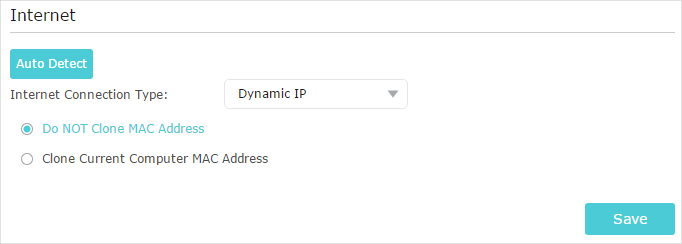
2 )If you choose Static IP, enter the information provided by your ISP in the corresponding fields.
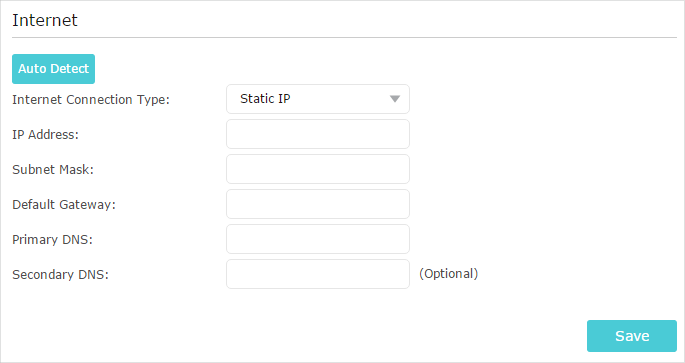
3 )If you choose PPPoE, enter the username and password provided by your ISP. PPPoE users usually have DSL cable modems.
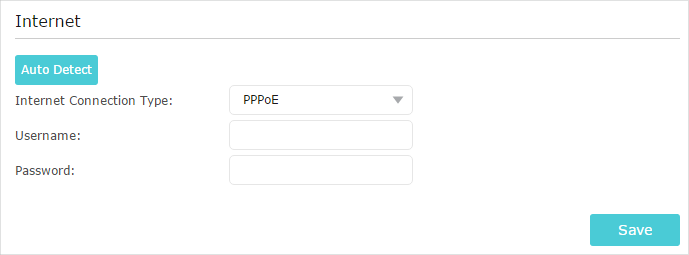
4 )If you choose L2TP, enter the username and password and choose the Secondary Connection provided by your ISP. Different parameters are needed according to the Secondary Connection you have chosen.
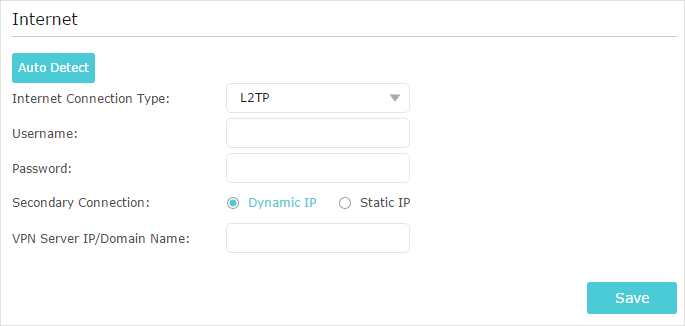
5 )If you choose PPTP, enter the username and password, and choose the Secondary Connection provided by your ISP. Different parameters are needed according to the Secondary Connection you have chosen.
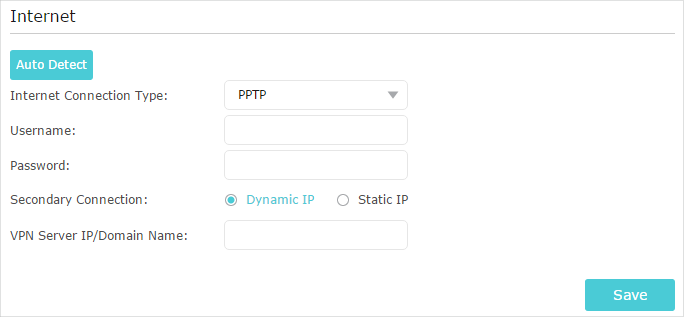
5.Click Save.
6.To check your internet connection, click Network Map on the left of the page. After the connection succeeds, the screen will display as follows. Here we take PPPoE as an example.
Note:
It may take 1-2 minutes to make the settings valid.
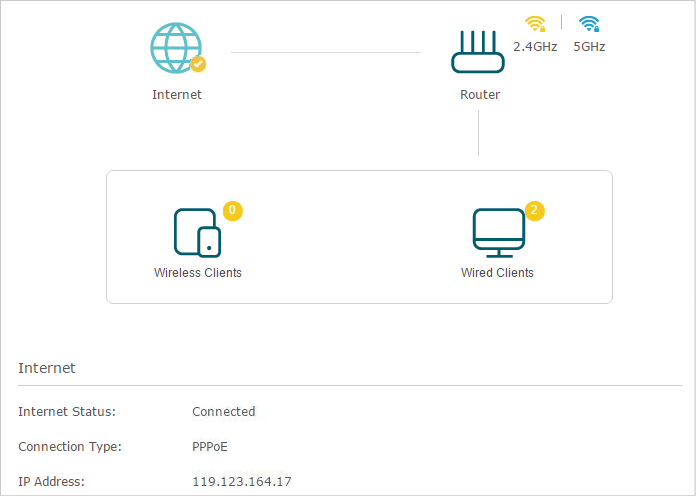
Tips:
•If your internet connection type is BigPond Cable, please go to Advanced > Network > Internet to set your router.
•If you use Dynamic IP and PPPoE and you are provided with any other parameters that are not required on the page, please go to Advanced > Network > Internet to complete the configuration.
•If you still cannot access the internet, refer to the FAQ section for further instructions.
3. Set Up an IPv6 Internet Connection
Your ISP provides information about one of the following IPv6 internet connection types: PPPoE, Dynamic IP(SLAAC/DHCPv6), Static IP, 6to4 tunnel and Pass-Through (Bridge).
1.Visit http://tplinkwifi.net, and log in with your TP-Link ID or the password you set for the router.
2.Go to Advanced > IPv6.
3.Enable IPv6 and select the internet connection type provided by your ISP.
Tips:
If you do not know what your internet connection type is, contact your ISP or judge according to the already known information provided by your ISP. Click on the management interface to know more about items.
4.Fill in information as required by different connection types. Red blanks must be filled in.
1 )Static IP: Select this type if your ISP uses Static IPv6 address assignment. Fill in blanks and click Save.
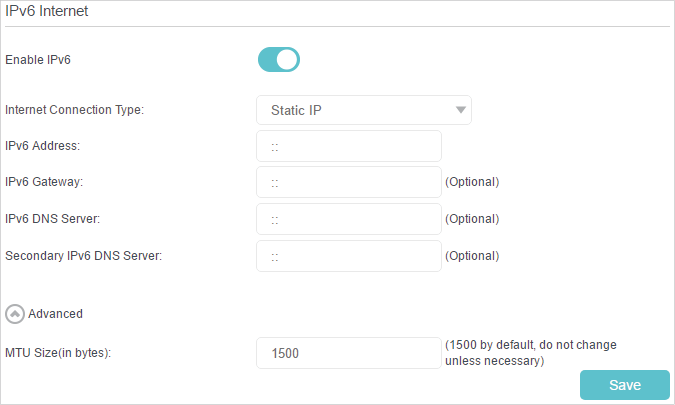
2 )Dynamic IP(SLAAC/DHCPv6): Select this type if your ISP uses Dynamic IPv6 address assignment. Click Advanced to input further information if your ISP requires. Click Save.
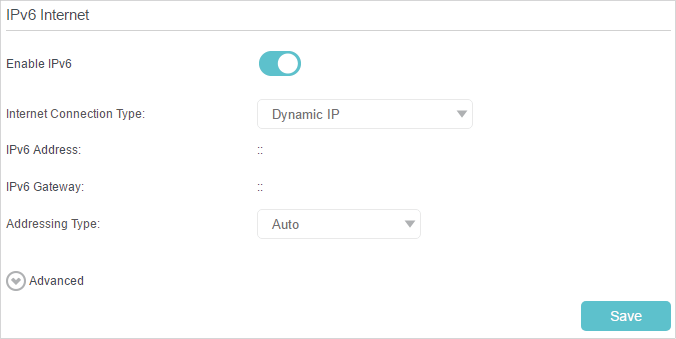
3 )PPPoE: Select this type if your ISP uses PPPoEv6, and provides you with a username and password. By default, the router uses the IPv4 account to connect to the IPv6 server. Click Advanced to input further information if your ISP requires. Click Save.
Note:
If your ISP provides two separate accounts for the IPv4 and IPv6 connections, please uncheck the box for Use the IPv4 connection’s PPPoE session and manually enter the username and password for the IPv6 connection.
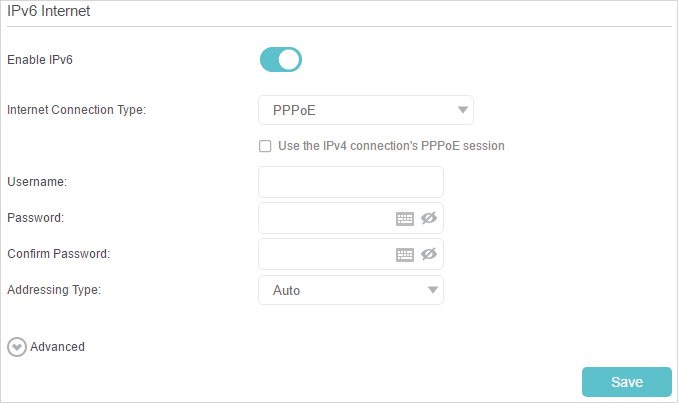
4 )6to4 Tunnel: An IPv4 internet connection type is a prerequisite for this connection type (Manually Set up Your Internet Connection). Select this type if your ISP uses 6to4 deployment for assigning address. Click Save.
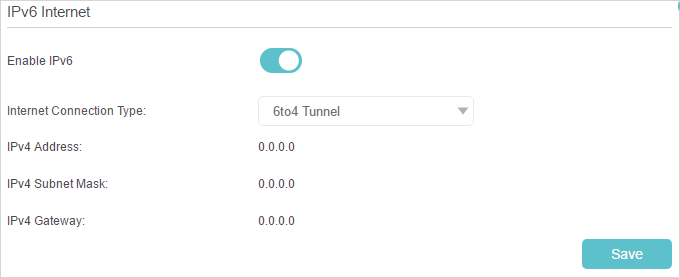
5 )Pass-Through (Bridge): Select this type if your ISP uses Pass-Through (Bridge) network deployment. No configuration is required for this type of connection.Click Save and skip to step 6.

5.Configure LAN ports. Select the appropriate Address Type and Site Prefix Type according to your ISP. Click Save.
Tips:
Click on the management interface to know more about items.
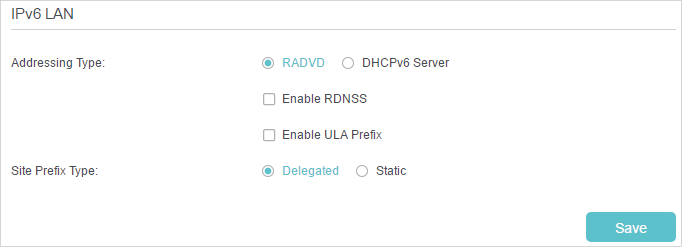
6.Click Status to check whether you have successfully set up an IPv6 connection. The following figure is an example of a successful PPPoE configuration.
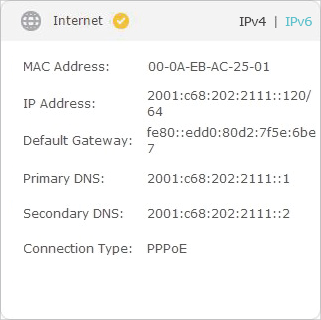
Tips:
Visit the FAQ section if there is no internet connection.